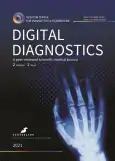Diagnostic accuracy of computed tomography for identifying hospitalizations for patients with COVID-19
- Autores: Morozov S.P.1, Reshetnikov R.V.1,2, Gombolevskiy V.A.1, Ledikhova N.V.1, Blokhin I.A.1, Mokienko O.A.1
-
Afiliações:
- Moscow Center for Diagnostics and Telemedicine
- I.M. Sechenov First Moscow State Medical University (Sechenov University)
- Edição: Volume 2, Nº 1 (2021)
- Páginas: 5-16
- Seção: Original Study Articles
- URL: https://journals.rcsi.science/DD/article/view/46818
- DOI: https://doi.org/10.17816/DD46818
- ID: 46818
Citar
Resumo
BACKGROUND: In Russia, a semi-quantitative CT 0–4 scoring system is used in the analysis of thoracic computed tomography (CT) scans of COVID-19 patients to grade the severity of lung lesions. Despite the widespread use of this approach, the scoring system’s diagnostic accuracy for identification hospitalizations for patients with the disease is currently unknown.
AIM: To evaluate the sensitivity, specificity, positive (PPV) and negative (NPV) predictive value of the CT 0–4 system for the triage of COVID-19 patients.
MATERIALS AND METHODS: This retrospective study enrolled 575 patients of Moscow clinics with laboratory-verified COVID-19, aged 57.2±13.9 years, 55% females. All patients were examined with four consecutive chest CT scans, and the disease severity was assessed using the CT 0–4 scoring system. Sensitivity and specificity were calculated as conditional probabilities that a patient would experience clinical improvement or deterioration, depending on the preceding CT examination results. For the calculation of the NPV and PPV, we estimated the COVID-19 prevalence in Moscow. The data on total cases of COVID-19 from March 6 to November 28, 2020, were taken from the Rospotrebnadzor website. We used several ARIMA and EST models with different parameters to fit the data and forecast the incidence.
RESULTS: The median specificity of the CT 0–4 scoring system was 69% (95% CI 32%, 100%), and the sensitivity was 92% (95% CI 74%, 100%). The best statistical model describing the epidemiological situation in Moscow was ARIMA (0,2,1). According to our calculations, with the predicted point prevalence of 9.6%, the values of PPV and NPV were 56% and 97%, correspondingly.
CONCLUSION: The maximum Youden’s index was observed for the period between the first and the second chest CT examinations when the majority of the included patients experienced clinical deterioration. The CT 0–4 scoring system makes it possible to safely exclude the development of pathological changes in patients with mild and moderate disease (categories CT-0 and CT-1), thereby optimizing the burden on hospitals in an unfavorable epidemic situation.
Palavras-chave
Texto integral
##article.viewOnOriginalSite##Sobre autores
Sergey Morozov
Moscow Center for Diagnostics and Telemedicine
Email: morozov@npcmr.ru
ORCID ID: 0000-0001-6545-6170
Código SPIN: 8542-1720
MD, Dr.Sci. (Med), Professor
Rússia, MoscowRoman Reshetnikov
Moscow Center for Diagnostics and Telemedicine; I.M. Sechenov First Moscow State Medical University (Sechenov University)
Autor responsável pela correspondência
Email: reshetnikov@fbb.msu.ru
ORCID ID: 0000-0002-9661-0254
Código SPIN: 8592-0558
Cand.Sci. (Phys-Math)
Rússia, MoscowVictor Gombolevskiy
Moscow Center for Diagnostics and Telemedicine
Email: gombolevskiy@npcmr.ru
ORCID ID: 0000-0003-1816-1315
Código SPIN: 6810-3279
MD, Cand.Sci. (Med)
Rússia, MoscowNatalya Ledikhova
Moscow Center for Diagnostics and Telemedicine
Email: n.ledikhova@npcmr.ru
Código SPIN: 6907-5936
Rússia, Moscow
Ivan Blokhin
Moscow Center for Diagnostics and Telemedicine
Email: i.blokhin@npcmr.ru
ORCID ID: 0000-0002-2681-9378
Código SPIN: 3306-1387
Rússia, Moscow
Olesya Mokienko
Moscow Center for Diagnostics and Telemedicine
Email: o.mokienko@npcmr.ru
ORCID ID: 0000-0002-7826-5135
Código SPIN: 8088-9921
MD, Cand.Sci. (Med)
Rússia, MoscowBibliografia
- Coronavirus update (live) [cited 2002 Oct 20]. Available from: https://www.worldometers.info/coronavirus
- World Health Organization. Coronavirus disease 2019 (COVID-19): situation report, 46 [cited 2002 March 06]. World Health Organization, Geneva; 2020. Available from: https://www.who.int/docs/default-source/coronaviruse/situation-reports/20200306-sitrep-46-covid-19.pdf?sfvrsn=96b04adf_4
- Temporary guidelines «Prevention, diagnosis and treatment of new coronavirus infection (COVID-19). Version 9 (26.10.2020)» (approved by the Ministry of Health of the Russian Federation) [Internet]. (In Russ). Available from: http://disuria.ru/_ld/8/846_mrC19pdl261020.pdf
- Morozov SP, Gombolevskiy VA, Cherninа VYu, et al. Prediction of lethal outcomes in COVID-19 cases based on the results chest computed tomography. Tuberculosis and Lung Diseases. 2020;98(6):7–14. (In Russ.) doi: 10.21292/2075-1230-2020-98-6-7-14
- Morozov SP, Andreychenko AE, Pavlov NA, et al. MosMedData: chest CT scans with COVID-19 related findings dataset. medRxiv. 2020. doi: 10.1101/2020.05.20.20100362
- Hyndman RJ, Khandakar Y. Automatic time series forecasting: the forecast package for R. J Stat Softw. 2008;27(3). doi: 10.18637/jss.v027.i03
- Box GE, Jenkins GM, Reinsel GC, Ljung GM. Time series analysis: forecasting and control. John Wiley & Sons, Hoboken; 2015.
- Rospotrebnadzor. The epidemiological situation and the spread of COVID-19 in the world as of 8.00 Moscow Time on 28.11.2020. Available from: https://www.rospotrebnadzor.ru/region/korono_virus/epid.php
- R Core Team. R: A language and environment for statistical computing. R foundation for statistical computing. Vienna, Austria; 2020.
- Hyndman RJ, Athanasopoulos G, Bergmeir C, et al. forecast: Forecasting functions for time series and linear models. Semantic Scholar; 2020.
- Wickham H. ggplot2: elegant Graphics for Data Analysis. Springer-Verlag New York; 2016. doi: 10.1007/978-3-319-24277-4
- Hamilton MC, Lyen S, Manghat NE. Controversy in coronaViral Imaging and Diagnostics (COVID). Clin Radiol. 2020;75(7):557–558. doi: 10.1016/j.crad.2020.04.011
- Morozov S, Ledikhova N, Panina E, et al. Re: Controversy in coronaViral Imaging and Diagnostics (COVID). Clin Radiol. 2020;75(11):871–872. doi: 10.1016/j.crad.2020.07.023
- Li Y, Xia L. Coronavirus Disease 2019 (COVID-19): Role of Chest CT in Diagnosis and Management. AJR Am J Roentgenol. 2020;214(6):1280–1286. doi: 10.2214/AJR.20.22954
- Feng Z, Yu Q, Yao S, et al. Early prediction of disease progression in COVID-19 pneumonia patients with chest CT and clinical characteristics. Nat Commun. 2020;11(1):4968. doi: 10.1038/s41467-020-18786-x
- Bi Q, Wu Y, Mei S, et al. Epidemiology and transmission of COVID-19 in 391 cases and 1286 of their close contacts in Shenzhen, China: a retrospective cohort study. Lancet Infect Dis. 2020;20(8)911–919. doi: 10.1016/S1473-3099(20)30287-5
Arquivos suplementares









